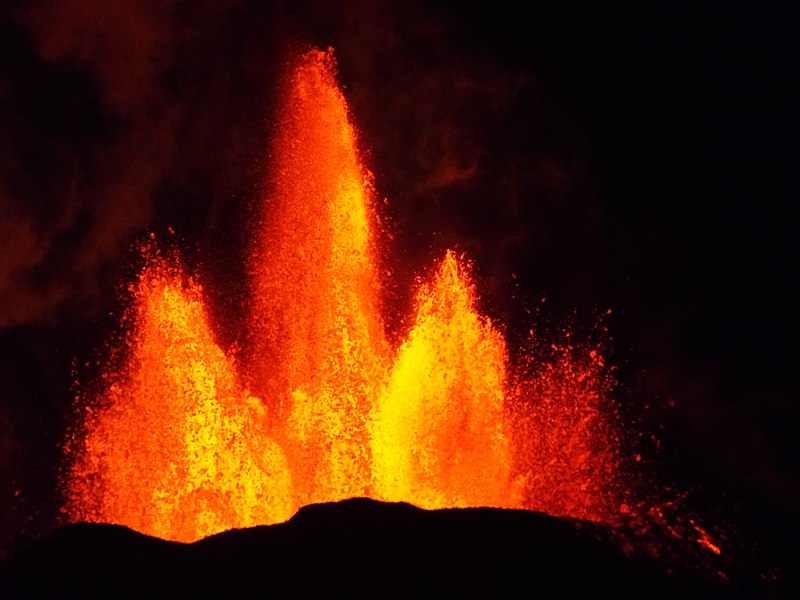Featured image: A fissure cone of Kīlauea (Hawaii) erupting during the 2018 eruptive episode. via Wikimedia commons (Public domain)
Paper: Role of volatiles in highly explosive basaltic eruptions.
Authors: Giuseppe La Spina, Fabio Arzilli, Mike R. Burton, Margherita Polacci, Amanda B. Clarke
When we think of Hawaii or Iceland, the first thing that comes to mind is volcanoes. Lava fountains spew out basaltic lava, which silently meanders its way to the ocean. The notion that basaltic eruptions are always less explosive compared to other types like rhyolitic and andesitic eruptions is not entirely true. For example, Mount Etna in Italy has produced highly explosive basaltic eruptions such as the 122 BCE Plinian Eruption and another in 1669. Because highly explosive basaltic eruptions are not very common, they’re not fully understood leaving scientists wondering “What could be the reason behind this erratic behaviour?”
This question led La Spina et al. to investigate how gases affect the behaviour of basaltic volcanic eruptions. The behaviour of magma (a mixture of molten rock and gases present beneath the surface) is controlled by the temperature, pressure, composition and trapped gases. Gases affect the speed at which the magma ascends from the magma chamber (a subsurface reservoir containing magma) to the surface, directly impacting the eruption style.
Magma contains numerous gases including sulphur dioxide, hydrogen sulphide, hydrogen fluoride, water vapour and carbon dioxide. Out of these, water and carbon dioxide are the most abundant ones and the gases that affect magma behaviour. If excess water is present, then the viscosity or the stickiness of the magma drops and causes it to become more buoyant. And so, with high water vapour, the magma ascends rapidly to the volcano’s vent.
However, if gaseous carbon dioxide is present in excess, the viscosity of the magma increases becoming stickier and thicker. This is because carbon dioxide doesn’t dissolve in magma as well as water and instead easily escapes out of the molten rock leaving behind a thicker magma. Therefore, any buoyancy that is imparted by water is counterbalanced by an increase in viscosity from carbon dioxide.
La Spina and colleagues simulated volcanic eruptions with magma containing varying proportions of carbon dioxide and assessed the impact on their explosivity. They found that dissolved carbon dioxide in the magma alone isn’t enough to produce an explosive eruption. The pressure required for a highly explosive eruption is attained only when additional carbon dioxide is injected into the magmatic system externally. They suggest that this may come from carbonate rocks that are in contact with the magma chamber.

It has been a long-held idea that how easily gases escape from the magma controls the style of eruption. For example, if the water content is high, the ascending magma is more fluid and then the volatiles escape easily from the magma resulting in lava fountaining. While early geologists thought that highly explosive basaltic eruptions were linked to high water content, La Spina and colleagues provide evidence that basaltic magmas with low water content can also produce highly explosive Plinian – like eruptions. This study shows in simulations that low viscosity magma, due to low water content makes it difficult for gases to escape. And as the magma nears the vent of the volcano, it fragments into pieces producing an explosive eruption. In contrast, researchers found that carbon dioxide has little to no effect on the explosivity of such basaltic eruptions.
This study has shed light on the understudied violent nature of basaltic volcanism. The findings will help to improve the existing models for predicting volcanic eruptions and mitigating future risks.
Understanding highly explosive basaltic eruptions using simulations by Amber Saraf is licensed under a Creative Commons Attribution-ShareAlike 4.0 International License.

